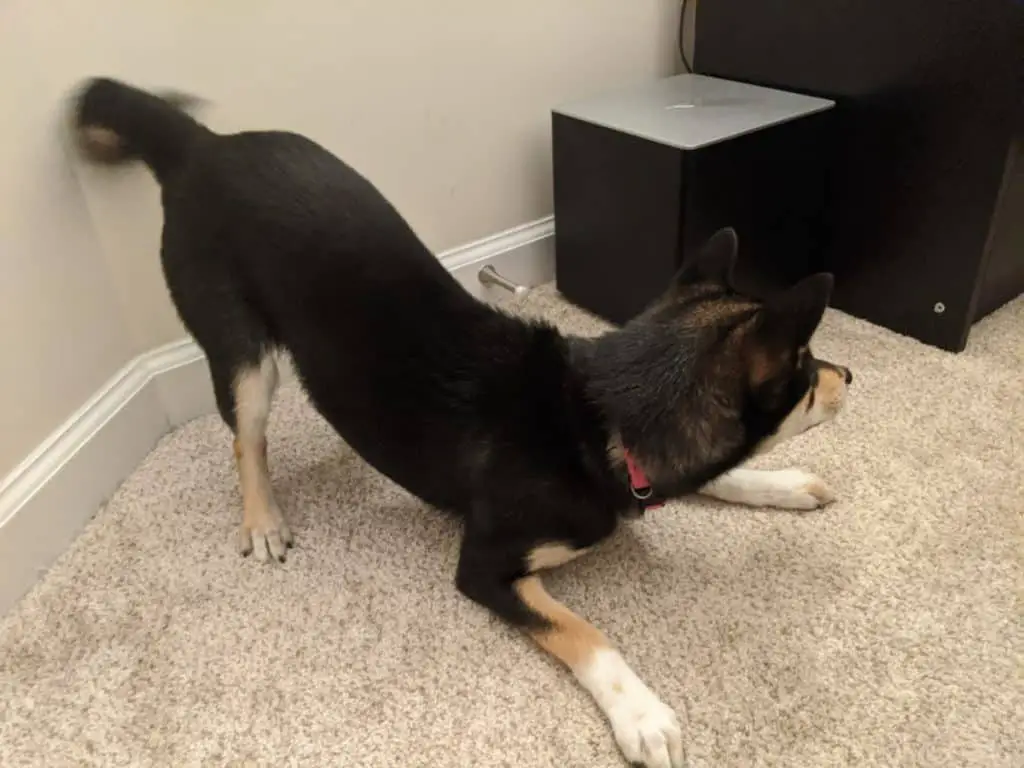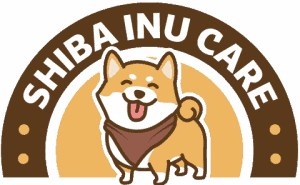This post contains affiliate links.
Shiba Inus are highly expressive dogs, and learning to understand their body language can significantly enhance the bond between you and your furry friend.
As an owner, it’s essential to be in tune with your Shiba Inu’s various signals, so you can better care for their needs and create a harmonious environment.

Why Is Body Language Important For Dogs?
As a dog owner, it’s essential to understand your pet’s body language, especially for Shiba Inus. This breed, known for its strong temperament and independent spirit, communicates through various cues that allow you to gauge their mood, comfort level, and needs.
What Common Moods Do Shibas Communicate?
Playfulness: When your Shiba Inu is feeling playful, you’ll notice their body language becoming more animated. They may bow down with their front paws stretched out and their rear end up in the air. Their tail might wag excitedly, and they may bounce or pounce around.
Submission: In a submissive mood, your Shiba Inu might lower their head, avoiding direct eye contact. Their ears might be flattened against their head, and they might tuck their tail between their legs.
Fear: When your Shiba Inu is scared or unsure, they tend to crouch down, trying to make themselves appear smaller. Their ears may be pinned back, and their tail might be tucked. They could also turn their head away from the perceived threat, avoiding eye contact.
Relaxed: A relaxed Shiba Inu will have a loose and wiggly body posture. Their mouth may be open slightly, and their tail might hang down or wag gently. Their ears will be in a neutral position, neither forward nor flattened.
Alert: If your Shiba Inu senses something of interest, they will become alert and focus their attention on it. Their body will be tense, and their ears and tail will be erect. They may also sniff the air or stare intently at the object of interest.
By observing and understanding these body language cues, you can be more responsive to your Shiba Inu’s needs and better navigate various situations that may arise. Remember to always remain patient, and keep in mind that each dog is unique.
How To Read A Shiba Inu’s Body Language
Tail Position
A Shiba Inu’s tail can tell you a lot about their emotions. When your Shiba Inu is relaxed, their tail will be down, slightly curved. If they’re happy, their tail will be up and may have a wagging motion.
A fearful or anxious Shiba Inu might tuck their tail between their legs. Keep an eye on the tail to gauge their feelings.
Ear Position
Ears are another essential aspect of Shiba Inu body language. Pay attention to the following positions:
- Alert: Ears forward, they’re focusing on something, possibly a noise or an object.
- Relaxed: Ears neutral, your Shiba Inu is content.
- Airplane ears: Ears held slightly to the side, signaling submission or uncertainty.
- Pinned back: Ears laying flat, indicating fear or anxiety.
Eye Contact
Shibas can express themselves through eye contact. If they make direct eye contact, they could be seeking attention or affection. However, if the eye contact is very intense and accompanied by bared teeth or growling, this could be a sign of aggression.
Body Posture And Stance
Your Shiba Inu’s body posture can show their mood or needs. Here are some common postures:
- Confident: Chest out, head held high, your Shiba Inu feels secure and in control.
- Submissive: Lowered body, head down, your Shiba Inu wants to show they’re not a threat.
- Playful: Bum up in the air, front paws lowered (play bow), inviting you to join in the fun.
- Anxious or fearful: Hunched over, making themselves appear smaller, possibly accompanied by whining or trembling.
Other Nonverbal Forms Of Communication
Shibas use a variety of nonverbal cues to communicate their feelings. Some common ones include:
- Barking: Can mean excitement, boredom, frustration, or seeking attention. Observe the situation to determine the cause.
- Whining: May signal discomfort, pain, anxiety, or a need for something like food or exercise.
- Chewing: Can be a sign of stress or separation anxiety. Provide a toy or address the source of stress.
- Facial expressions: Watch for raised eyebrows, blinking, lip licking as signs of anxiety or stress, or for relaxed and playful expressions when your furry friend is content or happy.
How To Tell If A Shiba Inu Is Friendly
Signs A Shiba May Be Aggressive
It’s important to learn your Shiba Inu’s body language to understand if they are being friendly or aggressive. A few aggressive signs to look for include:
- Stiff body posture and tensed muscles
- Baring teeth or growling
- Hair standing up on the back
- Direct eye contact, sometimes accompanied by a low, guttural sound
If you see any of these signs, give your Shiba some space to calm down and avoid getting too close.
Common Signs Of Shiba Inu Anxiety
Just like humans, Shibas can experience anxiety too. Knowing the signs of anxiety can help you provide comfort for your dog. Here are some common signs of anxiety in Shiba Inus:
- Pacing or restlessness
- Excessive panting or drooling
- Whining or whimpering
- Hiding or trying to escape
- Shivering or trembling
When you notice any of these anxiety symptoms, try to determine the cause and make adjustments for their comfort.
How Can I Use Body Language To Make My Shiba Inu Happy?
Understanding your Shiba’s body language is crucial for building a strong bond. To make your Shiba Inu happy and comfortable, pay attention to these body language cues:
- Relaxed body posture: When your dog has a loose, relaxed stance, it’s a sign they are happy and content.
- Wagging tail: A wagging tail, especially at a fast pace, indicates excitement and friendliness.
- Play bow: If your Shiba stretches their front legs out and lowers their chest to the ground, this is an invitation to play.
Remember to respond positively to these signs and engage with your dog when they are showing friendly body language. This will help reinforce the bond between you and your Shiba Inu.
Summary
These adorable pups have quite a way of expressing themselves! They’re known for their unique and sometimes puzzling expressions. Let’s just jump right in and explore some essential aspects of their body language.
When it comes to your Shiba Inu’s ears, you’ll be able to observe their emotions quite easily. Upright ears signify that your buddy is alert and engaged, while when they lay their ears back, it usually means they’re feeling a bit anxious or scared.
Now, let’s talk about their tails. A wagging tail in a Shiba Inu doesn’t always mean they’re excited, just like with other dogs. But when it’s curled up, it generally indicates that they’re feeling relaxed or content. Unfurling of the tail can reveal a bit of stress or fear.
Shiba Inus are also known for their stunning eyes that can seem to read your soul! When your companion engages in prolonged eye contact, it indicates they trust you and want to connect. But be aware, if they start avoiding eye contact, it might be an aversion to a specific person or situation.
Some key body language cues in your Shiba Inu:
- Upright ears: Alert and engaged
- Ears back: Anxious or scared
- Curled tail: Relaxed or content
- Unfurled tail: Stressed or fearful
- Prolonged eye contact: Trust and connection
- Avoiding eye contact: Aversion or discomfort
So, go ahead and observe your Shiba Inu’s behavior and expressions, and remember that patience and understanding are crucial. Once you get the hang of it, you’ll be able to communicate better with your furry companion and develop an even stronger bond.
Frequently Asked Questions
Why Is My Shiba Inu Avoiding Eye Contact?
Shiba Inus may avoid eye contact because they consider it a sign of dominance or aggression. It’s not necessarily a problem, but be aware of your dog’s body language and avoid staring contests. They may gradually become more comfortable making eye contact with you as they trust you more.
Why Is My Shiba Inu Shaking?
Shaking can be a sign of stress, anxiety, or discomfort. Check if any environmental factors may be causing the shaking, such as too much noise or cold temperatures. If your Shiba Inu continues shaking frequently, it’s a good idea to consult with a vet to help identify any underlying health issues.
How Do Shiba Inus Show Love?
Shiba Inus can show love in various ways. This may include cuddling, following you around, wagging their tail, and licking your face. Each Shiba is unique, and some may be more affectionate than others.
What Does It Mean When A Shiba’s Tail Is Down?
A Shiba Inu with its tail down could indicate submission, fear, or discomfort. Observe whether your dog’s body is tense or relaxed to gain a better understanding of their feelings. A relaxed dog may briefly lower its tail, which is normal behavior.
How Do I Know If My Shiba Inu Is Happy?
A happy Shiba Inu often exhibits an erect tail, relaxed ears, and an overall playful demeanor. Look out for body language like play bows, wagging tails, and engaged expressions to know if your Shiba Inu is content.
Do Shiba Inus Only Attach To One Person?
Shiba Inus can form strong bonds with their primary caregiver, but they are also capable of bonding with multiple people. Socialize your Shiba with friends and family to ensure they build attachments with others in your circle.
Do Shiba Inus Have A Favorite Person?
Though Shiba Inus can bond with multiple people, they often have a favorite person they feel the closest to – usually the primary caregiver. This may change over time, depending on the dog’s experiences and connections with different people.
